2022 年浙江成人高考专升本英语真题及答案
本试卷分第Ⅰ卷(选择题)和第Ⅱ卷(非选择题)两部分。满分 150 分。考试时间 150 分
钟。
第 I 卷(选择题,共 125 分)
一、Phonetics(5 points)
Directions:In each of the following groups of words, there are four underlined letters
or letter combinations marked A, B, C and D.Compare the underlined parts and identify
the one that is different from the others in pronunciation. Mark your answer by
blackening the corresponding letter on the Answer Sheet.
1.A. game
2.A. there
B. late
B. thick
C.trade
C.thank
D.have
D.thirty
3.A. useless
B. endless
C.unless
D.hopeless
4.A. cool
5. A.easy
B. flood
B. noisy
C.food
C.busy
D.moon
D.fantasy
二、Vocabulary and Structure (15points).
Directions: There are 15 incomplete sentences in this section. For each sentence there
are four choices marked A, B, C and D. Choose one answer that best completes the
sentence and blacken the corresponding letter on the Answer Sheet.
6 .This test is designed for students
native language is not English.
A.whose
B. whom
C. to whom
D. to whose
7. While
A. walk
C. to walk
along the shore, I found a lot of sea shells.
B. walking
D. walked
8.The sweater she received in the end differed
the one she had seen online..
A. by
B. in
C. with
D. from
9.There are numerous websites on the Internet
you can learn how to cook.
A. that
B. when
C. where
D. which
10.The writer’s first book is
popular than his second one.
�
A. so
B. less
C. such
D. much
11.Tom is a careless person. He forgot
the door again when he went out yesterday..
A. to lock
B. locking
C. to have locked
D. having locked
12.We generally have four people working in the shop, but at___periods we employ extra
hands.
A. top
B. rush
C. tip
D. peak
13.It is expected that by 2049 the population of the city ____two million.
A. would reach
B. will have reached
C. will be reaching
D. would have been reached
14.As the manager of this new company, Charles
lots of work and almost had no time
for
pleasure.
A. took to
B. took after
C. took on
D. took off
15.If John had entered the office ten minutes ago, he
what we were talking about just
now.
A. should know
B. had known
C. would know
D. would have known
16.Your brother Frank doesn’t eat cheese,
?.
A. is he
C. does he
B. isn't he
D. doesn’t he
17.Pets
constant care are not suitable for people with little spare time.
A. require
B. requiring
C. required
D. to require
18.Newspapers, magazines, televisions and computers all fight to
our attention.
A. hold
B. bring
C. carry
D. pull
19.My friend John didn’t like my suggestion
we should share the rent.
A. that
B. what
C. how
D. why
20.The old man’s clothes,
old and worn, looked clean and of good quality.
A. if
B. when
C. though
D. since
三、Close(30points).
Directions: For each blank in the following passage, there are four choices marked A,
B,C and D. Choose the one that is most suitable and mark your answer by blackening
the corresponding letter on the Answer Sheet.
Many of us rely on our smart phones for our everyday cameras. Our phones, however,
�
collect lots of data
21
us, and camera software can automatically make a
22 mo of
our location when we take a photo. This is more often a potential safety 23 than a benefit.
Let's start with the
24
. When you allow your camera to mark your location, photo
Management apps, 25
Apple's Photos and Google Photos, can automatically
26
pictures into albums based on location. That's 27
when you go on vacation and want to
remember
28
you were when you took a picture.
But when you're not traveling, 29
your location marked on photos is not great. Let's
say you just connected with
30 on a dating app and shared a photo of your dog.
31
you had the location feature turned on when you took the photo, that person could_32_the
data to see where you live.
Just to be 33 , make sure the photo location feature is off by default(默认情况下). You
34
choose to turn the location feature on
35
to document your vacation, but
remember to turn it off when your trip is over.
21.A.with
22.A.note
B.above
B.choice
C.about
C.focus
23.A.harm
B.advantage
C.test
D.besides
D.call
D.risk
24.A.records
B.positives
C.satisfactions
D.points
25.A.of
26.A.sort
B.as
B.shape
C.with
C.reach
D.like
D.work
27.A.helpful
B.successful
C.doubtful
D.painful
B.where
B.hiding
C.why
C.having
D.how
D.allowing
B.everyone
C.anyone
D.someone
B.Though
B.analyze
C.Unless
C.copy
C.safe
D.Whether
D.erase
D.active
D.must
28.A.which
29.A.letting
30.A.none
31.A.If
32.A.edit
33.A.happy
B.easy
34.A.might not
B.might
C.must not
35.A.quickly
B.permanently
C.temporarily
D.slowly
IV. Reading Comprehension (60 points)
Directions: There are five reading passages in this part. Each passage is followed by five
questions. For each question there are four suggested answers marked A,B,C and D.
Choose one best answer and blacken the corresponding letter on the Answer Sheet.
�
Passage One
When my daughter first began competing in school chess tournaments, I often chatted
with other parents. Sometimes, I’d ask if they played chess themselves. Usually, the reply was
no. When I volunteered that I was learning to play, their tone was cheerfully joking:“Good
luck with that!”If this game is so good for kids, why are adults ignoring it? Seeing someone
playing smart phone games, I wanted to say:“Why are you having your kids do chess while
you do that?"
Sure, we parents had work to do, work that helped pay for the lessons our kids were
enjoying. But I also wondered if we were sending a subtle message:that learning was for the
young. During one tournament, I saw a group of parents. They were playing chess! Just then,
a group of kids passed me.“Why are adults learning chess?” one asked, in a vaguely teasing
tone.
I was tired of sitting on the sidelines. I wanted in. And that is how I got a membership
card and started throwing myself in. Early on, I was nervous, even though I really had nothing
to lose, except my pride. “ A master can sometimes play badly," as one grandmaster (国际象
棋大师)put it,“a fan, never!And fan I was. It was three hours of concentration and thinking,
with my phone turned off. It felt like a gym for the brain.
Being a beginner can be hard at any age, h out it gets harder as you get older. The
phrase“adult beginner" has an air of gentle pity. It implies the learning of something that you
should have perhaps already learned.
36.What can we learn about other parents from their remarks in Para 1?
A. They were indifferent to adult learners.
B. They agreed om the idea of learning chess.
C.They gave congratulations to the adult learner.
D.They thought it odd for an adult to learn chess.
37.What was a group of parents doing during one tournament in Para. 2??
A. Playing chess.
B. Enjoying chatting.
C.Watching kids play chess.
D. Helping kids with their lessons.
38.Which of the following is closest in meaning to“sitting on the sidelines”in Para. 3?
A.Not being noticed. B. Expressing vague ideas.
B.Expressing vague ideas.
C.Not being involved.
D.Following what others do.
�
39.What did the writer think of his experience of learning to play chess?
A.It helped him remain calm.
B. It helped him train his brain.
C. It made him proud of himself.
D. It made him question himself.
Passage Two
There's an old fixed understanding about the difference between cats and dogs. Dogs
are loving an loyal,while cats are aloof(冷漠离群的)and indifferent. Most cat people, however,
probably disagree. Overall, cat research suggests cats do form emotional bonds with their
owners. Cats seem experience separation anxiety, respond to their owners’ voices more than
to strangers’ and look for comfort when scared.
But a new study reveals a more complicated picture of our relationship with cats.
Adapting a method previously used to study dogs,
the scientists found cats-unlike
dogs-don’t avoid strangers who refuse to help their owners. This doesn’t mean that the cats
in this study were selfish, but they simply didn't understand how human beings respond to
each other. They weren’t aware that some of the strangers were being unhelpful.
In an experiment, a cat watched as her owner tried to open a box to get at something
inside. Two strangers sat on either side of the owner and the owner turned to one of them
and asked for help. In “ helper ” trials, the stranger helped the owner to open the box. In
“ non-helper ” trials, the stranger refused. The other stranger sat passively, doing nothing.
Then, both strangers offered the cat a treat, and the scientists watched to see which stranger
the cat approached first. Did she prefer to take food from a helpful stranger over a passive
one? Or did she avoid taking food from the non-helper?
When this method was used to test dogs, they showed a clear preference. The dogs
preferred not to take food from a stranger who refused to help their owner. In contrast, the
cats in the study were completely indifferent. They showed no preference for the helpful
person and no avoidance( 避 开 ) of the unhelpful person. Apparently, as far as cats are
concerned, food is food.
What should we take from this? An attractive conclusion would be that cats are selfish
and don't care about how their owners are treated at all. This is an example of
human-centered thinking of animals. To really understand cats, we have to get out of this
�
view and think of them as cats.
40. What do most cat people probably disagree with, according to Para. 1?
A. Cats are strange.
B. Cats are loving.
C.Cats are caring.
D. Cats are cold.
41. What does most research about cats show?
A. They don't need their owners’ attention.
B.They are emotionally attached to their owners.
C.They don't experience separation anxiety as dogs do.
D.They respond to their owners’ voices less than dogs do.
42.What can be learned from the study?
A. Cats take food no matter who feeds them.
B.Cats refuse food from unhelpful strangers.
C.Dogs refuse food from those who anger them.
D.Dogs take food no matter how they are treated.
43.What should we do to better understand cats, according to the last paragraph?
A. To treat them as friends.
B. To compare them with dogs.
C.To regard them as animals.
D. To care about their behavior.
Passage Three
Scientists have shown that exercise is linked to brain changes throughout all stages of life
and can help the brain develop and stay healthy. Babies,for example, need regular exercise
to form connections in the brain.In children, research suggests that exercise improves
attention, focus and school performance. In the elderly, exercise has been shown to help
slow memory loss.
Then how does exercise help the brain? Over the last 20 years, scientists have learned
that exercise can help keep the mind sharp in a number of ways. Exercise improves blood
flow to the brain.The blood carries oxygen, contributing to more efficient connections
between brain cells. Increasing blood flow is one way that exercise can improve mental
abilities. The positive effects of exercise on the brain can be seen in babies, pre-teenagers
and adults.
Babies are in near-constant movement, which is extremely important for development.
�
This movement not only strengthens their muscles, but also helps their brains form
connections. The process continues throughout life but is most intense in infancy( 婴 儿
期 )and toddlerhood( 学 步 期 ) , when children are mastering brand-new skills like sitting,
standing, walking, running and jumping
Exercise is also healthy for pre-teenagers’ brains. In fact, some research suggests that
regular exercise can improve school performance. A study found that the effects depended
on how much kids exercised. The more days the children attended the exercise program,the
more their focus improved.
Finally, exercise helps keep the mind sharp during adulthood. Research suggests exercise
can increase the size of the hippocampus, an important area of the brain, which become
smaller with age, and can increase levels of a protein (蛋白质) that aids the growth of new
brain cells. This can help prevent older adults from losing mental abilities and memory.
44. How does exercise help the elderly?
A. By improving attention.
B. By slowing memory loss.
C. By connecting with others.
D. By controlling cell growth.
45. How does exercise sharpen the mind according to Para. 2 ?
A. By increasing the brain size.
B. By decreasing the protein level.
C. By extending the time of concentration.
D. By strengthening brain cells’ connections
46. What is crucial in the development of babies’ brains?
A. Babies’ ability to focus.
B. Babies’ mastery of skills.
C. Babies’ muscle strength.
D. Babies’ near-constant movement.
47.What is the main idea of the passage?
A. Exercise strengthens people's body
B. Exercise helps babies to grow
C. Exercise improves people's life.
D. Exercise benefits the brain.
�
Passage Four
In1542, Francisco de Orellana led the first European voyage down the Amazon River.
During this voyage the explorers met a lot of resistance(抵抗) from the local Indians. In one
particular tribe the women fighters were so fierce that they drove their male fighters in front
of them with spears. Thus the river was named after the famous women fighters of the
ancient Greek stories, the Amazons.
This voyage also started our wonder of the greatest river and the largest area of
rainforest in the world. About 20% of all fresh water carried to the oceans is from the Amazon
River. The Amazon basin is the world's largest, about the size of Europe. The river is a
product of the rainy season, which brings huge rains every summer. This also produces a
large area of rainforest, which supports the largest number of diverse plants and animals of
any area in the world.
The Amazon rainforest is also important when it comes to the future of global warming,
as it is a huge natural store of carbon. Up until recently it was thought that the Amazon had
fully grown and thus could not take up anymore CO2. Experiments have shown this could be
wrong and that the Amazon rainforest might be sucking up an additional five tons of
CO₂from the atmosphere per hectare(公顷) per year. This is because plants react favorably to
increased CO2; because it is the raw material for photosynthesis(光合作用),the more of it
the better. So having more CO2 in the atmosphere acts like a fertilizer,stimulating plant
growth.Because of the size of the Amazon rainforest, it seems that presently it is taking up a
large percentage of our CO2 pollution in the atmosphere, about 75% of the world ’ s car
pollution.
48.After whom was the Amazon River named ?
A. The Indian women fighters.
B. The head of an Indian tribe.
C. The first explorer of the river.
D.The women fighters in ancient Greek stories.
49. Which of the following statements is true ?
A.The Amazon basin is the largest in the world.
B.The Amazon River causes huge rains every summer.
C.The Amazon rainforest supports about 20% of the world’s plants.
D.The Amazon River carries 75% of the world's water to the oceans.
50.Why is CO₂ compared to a fertilizer in Para a. 3 ?
�
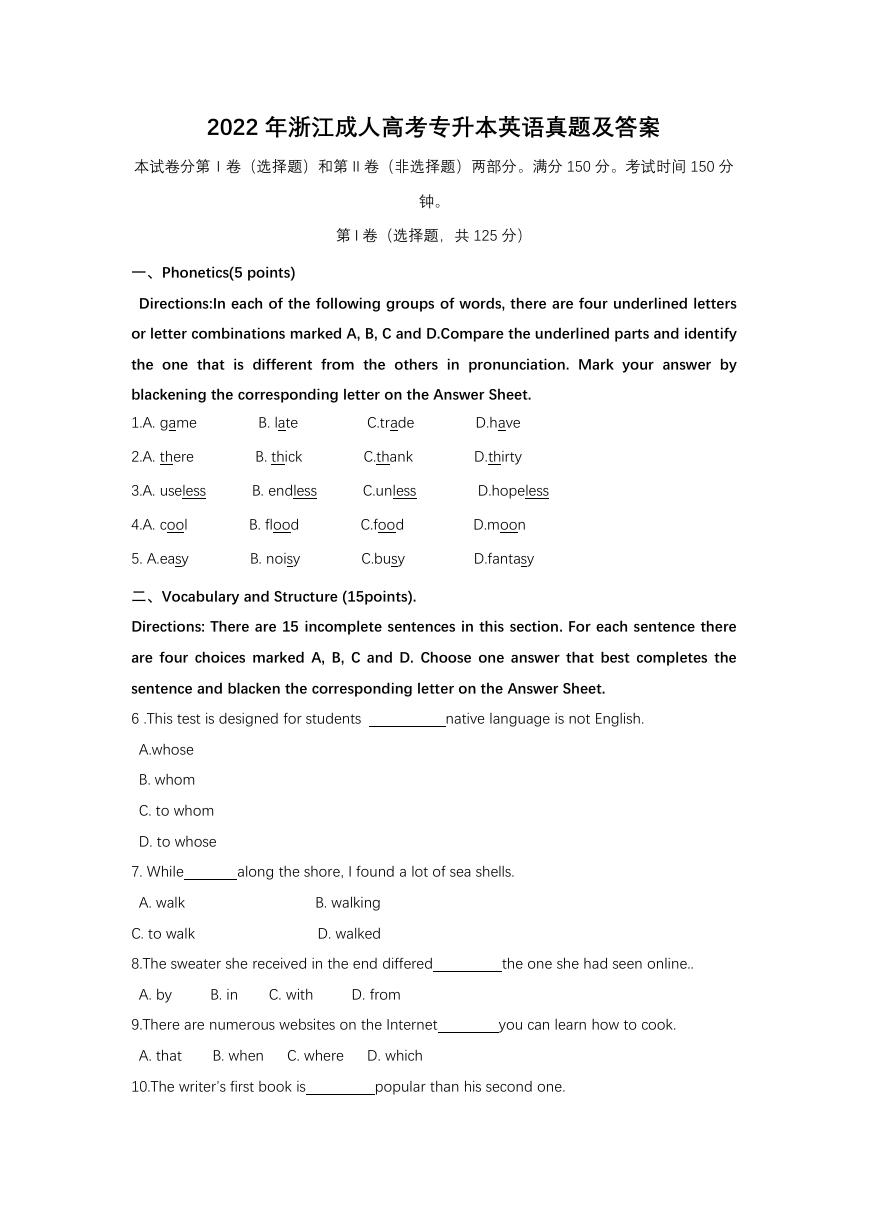
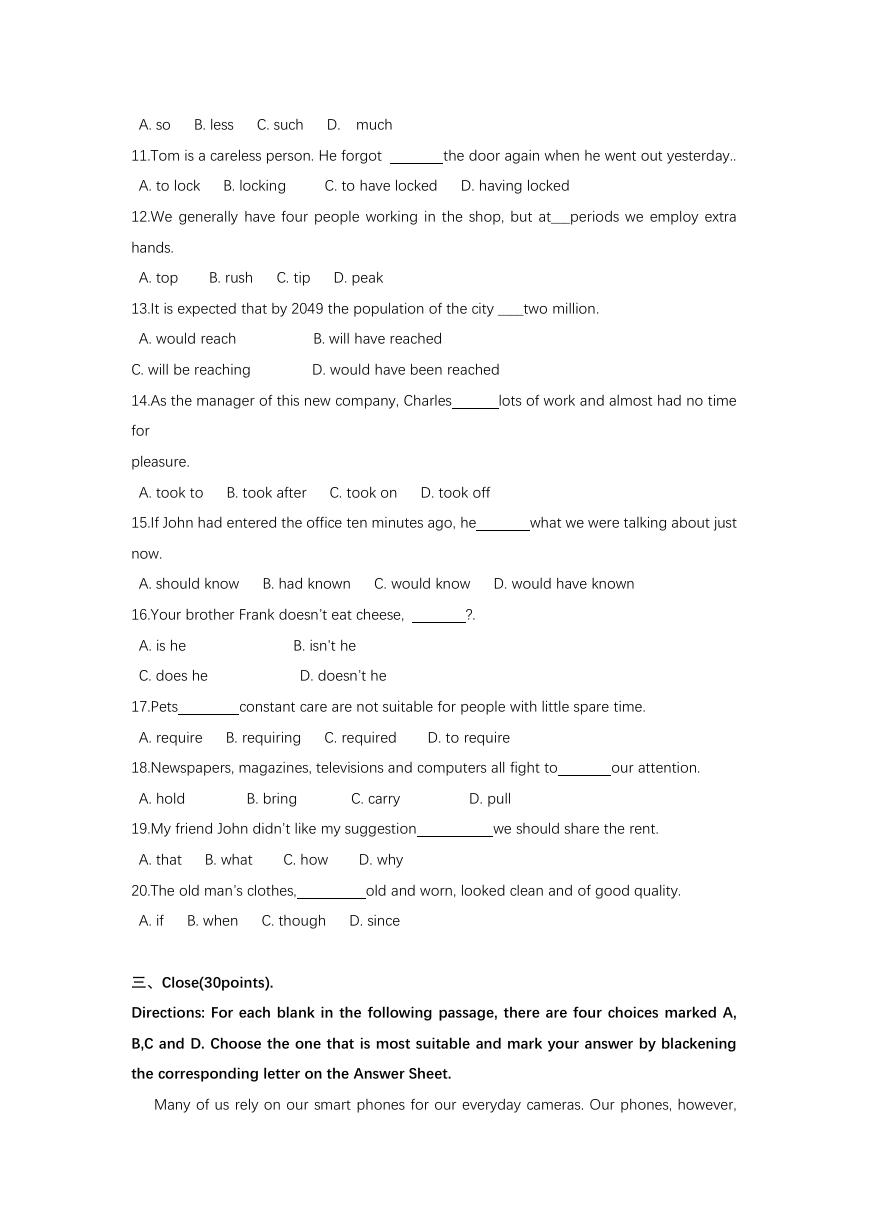

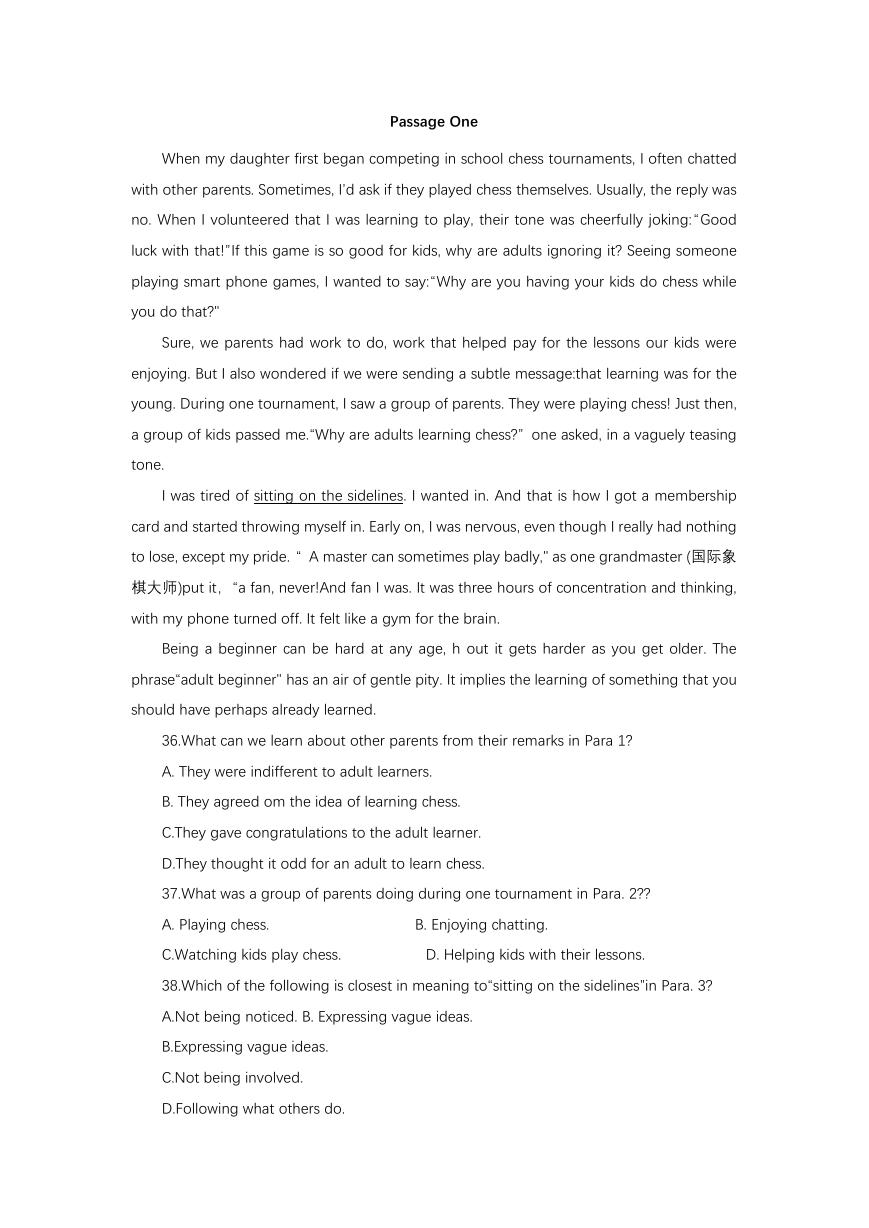
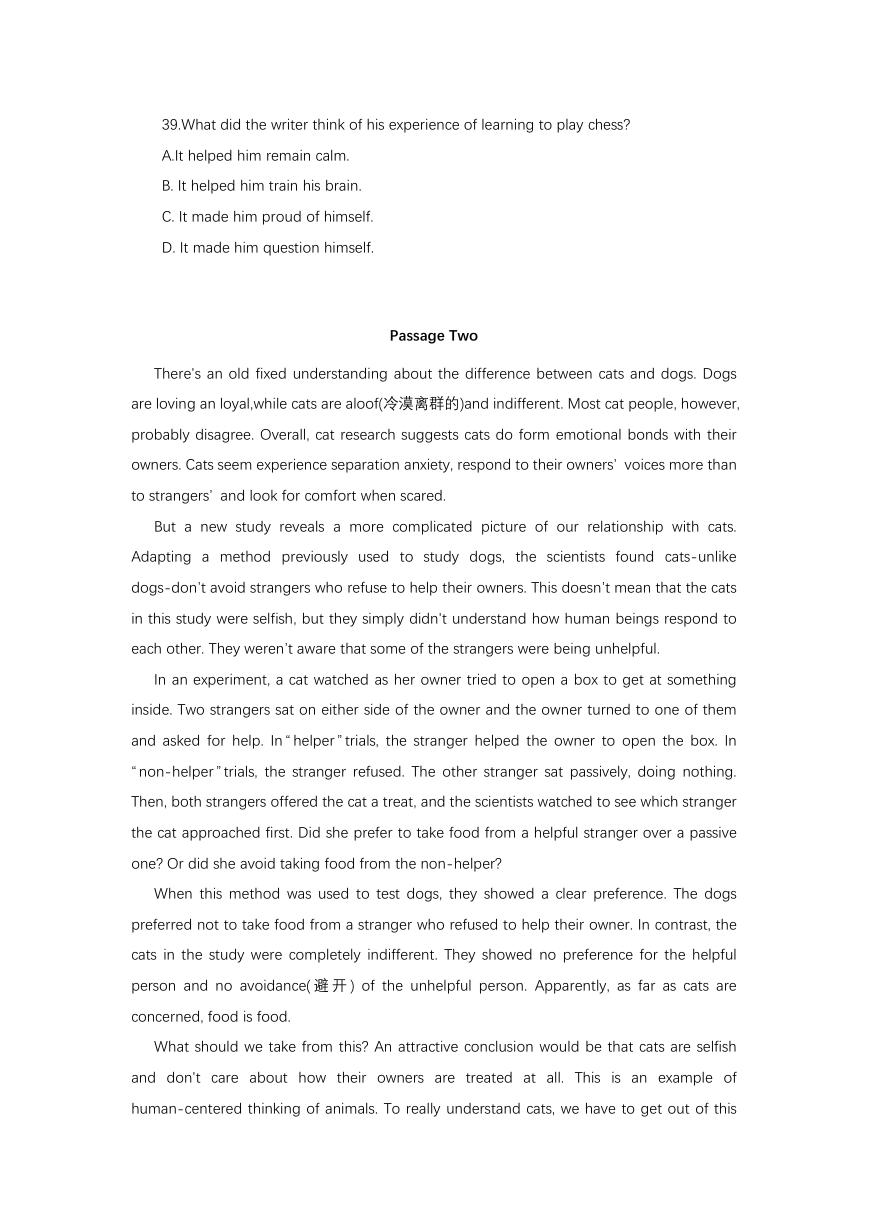

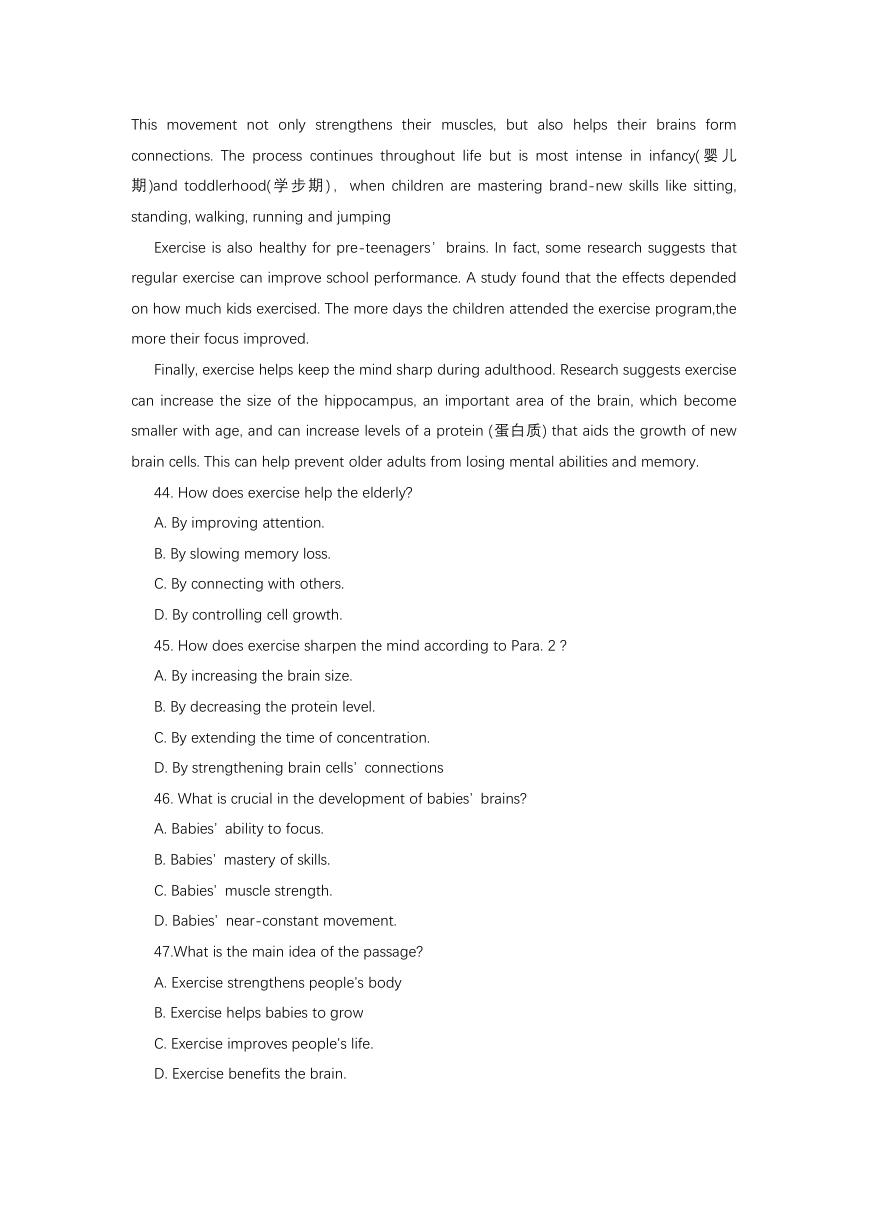









 2023年江西萍乡中考道德与法治真题及答案.doc
2023年江西萍乡中考道德与法治真题及答案.doc 2012年重庆南川中考生物真题及答案.doc
2012年重庆南川中考生物真题及答案.doc 2013年江西师范大学地理学综合及文艺理论基础考研真题.doc
2013年江西师范大学地理学综合及文艺理论基础考研真题.doc 2020年四川甘孜小升初语文真题及答案I卷.doc
2020年四川甘孜小升初语文真题及答案I卷.doc 2020年注册岩土工程师专业基础考试真题及答案.doc
2020年注册岩土工程师专业基础考试真题及答案.doc 2023-2024学年福建省厦门市九年级上学期数学月考试题及答案.doc
2023-2024学年福建省厦门市九年级上学期数学月考试题及答案.doc 2021-2022学年辽宁省沈阳市大东区九年级上学期语文期末试题及答案.doc
2021-2022学年辽宁省沈阳市大东区九年级上学期语文期末试题及答案.doc 2022-2023学年北京东城区初三第一学期物理期末试卷及答案.doc
2022-2023学年北京东城区初三第一学期物理期末试卷及答案.doc 2018上半年江西教师资格初中地理学科知识与教学能力真题及答案.doc
2018上半年江西教师资格初中地理学科知识与教学能力真题及答案.doc 2012年河北国家公务员申论考试真题及答案-省级.doc
2012年河北国家公务员申论考试真题及答案-省级.doc 2020-2021学年江苏省扬州市江都区邵樊片九年级上学期数学第一次质量检测试题及答案.doc
2020-2021学年江苏省扬州市江都区邵樊片九年级上学期数学第一次质量检测试题及答案.doc 2022下半年黑龙江教师资格证中学综合素质真题及答案.doc
2022下半年黑龙江教师资格证中学综合素质真题及答案.doc